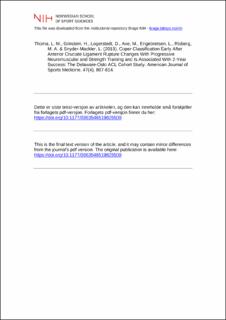| dc.contributor.author | Thoma, Louise M. | |
| dc.contributor.author | Grindem, Hege | |
| dc.contributor.author | Logerstedt, David | |
| dc.contributor.author | Axe, Michael | |
| dc.contributor.author | Engebretsen, Lars | |
| dc.contributor.author | Risberg, May Arna | |
| dc.contributor.author | Snyder-Mackler, Lynn | |
| dc.date.accessioned | 2020-05-11T07:34:28Z | |
| dc.date.available | 2020-05-11T07:34:28Z | |
| dc.date.created | 2019-06-12T13:37:55Z | |
| dc.date.issued | 2019 | |
| dc.identifier.citation | American Journal of Sports Medicine. 2019, 47(4), 807-814. | en_US |
| dc.identifier.issn | 0363-5465 | |
| dc.identifier.uri | https://hdl.handle.net/11250/2653770 | |
| dc.description | I Brage finner du siste tekst-versjon av artikkelen, og den kan inneholde ubetydelige forskjeller fra forlagets pdf-versjon. Forlagets pdf-versjon finner du på journals.sagepub.com / In Brage you'll find the final text version of the article, and it may contain insignificant differences from the journal's pdf version. The definitive version is available at journals.sagepub.com. | en_US |
| dc.description.abstract | Background: Some athletes demonstrate excellent dynamic stability after anterior cruciate ligament (ACL) rupture and return tosport without ACL reconstruction (ACLR) (copers). Others demonstrate persistent instability despite rehabilitation (noncopers) andrequire surgical stabilization. Testing to determine coper classification can identify potential copers early after rupture. It is unclearhow coper classification changes after a brief intervention and how early classification relates to long-term outcomes.Purpose:(1) To evaluate the consistency of early coper classification (potential coper vs noncoper) before and after progressiveneuromuscular and strength training (NMST) among athletes early after acute ACL rupture and (2) to evaluate the association ofearly coper classification with 2-year success after ACL rupture.Study Design:Cohort study; Level of evidence, 2.Methods:This was a prospective analysis from the Delaware-Oslo ACL Cohort Study, composed of athletes consecutively enrolledearly after ACL rupture. Participants (n = 271) were tested and classified as potential copers or noncopers according to established cri-teria before and after a 10-session NMST program. Success 2 years after ACLR or nonoperative rehabilitation was defined as meeting orexceeding sex- and age-matched norms for knee function, no ACL graft rupture, and 1 episode of giving way within the previous year.The McNemar test evaluated changes in coper classification pre- to posttraining. Logistic regression adjusted for baseline characteristicswas used to evaluate the association of early coper classification and surgical status with 2-year success.Results:Of 300 athletes enrolled, 271 (90%) completed the posttraining data collection, and 219 (73%) returned for the 2-year fol-low-up. The coper classifications were different between time points: nearly half of those classified initially as noncopers becamepotential copers (P\.001). At the 2-year follow-up, 66% of the ACLR group and 74% of the nonoperative group were successful.Athletes who were potential copers posttraining and chose ACLR or nonoperative rehabilitation had 2.7 (95% CI, 1.3-5.6) and 2.9(95% CI, 1.2-7.2) times the odds of success, respectively, as compared with noncopers who chose ACLR.Conclusion:Coper classification improved after NMST; more athletes became potential copers. Athletes who were potential co-pers after NMST were more likely to succeed 2 years later regardless of whether they had surgery, strongly supporting the addi-tion of NMST before ACLR. Persistent noncopers fared poorly, indicating that more intensive rehabilitation may be needed. | en_US |
| dc.language.iso | eng | en_US |
| dc.subject | ACL injury | en_US |
| dc.subject | coper classification | en_US |
| dc.subject | prehabilitation | en_US |
| dc.subject | neuromuscular training | en_US |
| dc.title | Coper Classification Early After Anterior Cruciate Ligament Rupture Changes With Progressive Neuromuscular and Strength Training and Is Associated With 2-Year Success: The Delaware-Oslo ACL Cohort Study | en_US |
| dc.type | Peer reviewed | en_US |
| dc.type | Journal article | en_US |
| dc.description.version | acceptedVersion | en_US |
| dc.source.pagenumber | 807-814 | en_US |
| dc.source.volume | 47 | en_US |
| dc.source.journal | American Journal of Sports Medicine | en_US |
| dc.source.issue | 4 | en_US |
| dc.identifier.doi | 10.1177/0363546519825500 | |
| dc.identifier.cristin | 1704352 | |
| dc.description.localcode | Seksjon for idrettsmedisinske fag / Department of Sports Medicine | en_US |
| cristin.ispublished | true | |
| cristin.fulltext | postprint | |
| cristin.qualitycode | 2 | |
